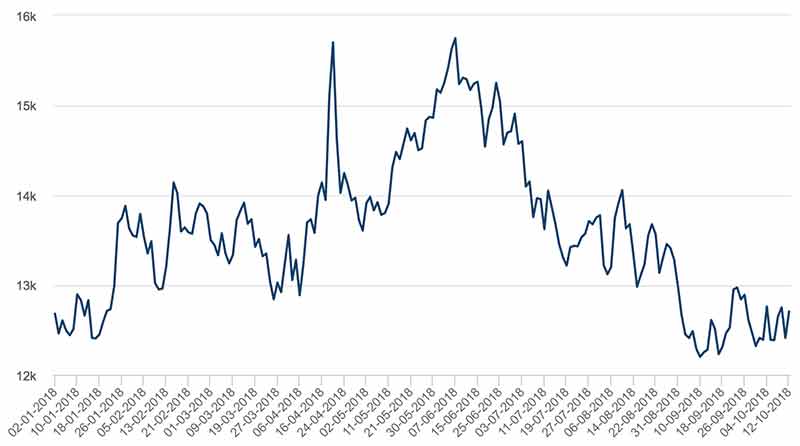Here’s what’s ahead for nickel, copper, lithium and cobalt prices

Pic: Getty
Escalating global trade tensions have helped drive down metal prices in the second half of the year – but the outlook isn’t all bad, according to leading analysts.
Despite precipitous price falls in many base and battery metals, year-to-date price averages are still higher than last year, according to Wood Mackenzie experts at last week’s LME Week event in London.
Nickel has been this year’s best performer, with average prices to the end of September 36 per cent higher compared with the same period in 2017.
Copper prices were up 12 per cent, zinc up 9 per cent, and lead up 3 per cent year-on year.
And while lithium and cobalt prices capitulated when massive amounts of new supply flooded the market – the “narrative remains positive for both metals given the rising requirements for EV [electric vehicle] and energy storage”, Wood Mackenzie says, reinforcing the consensus optimistic outlook from analysts and industry experts.

Nickel will recover in 2019
Despite falling substantially from its June peak of US$16,535/t, nickel demand this year, and into 2019, is strong, Wood Mackenzie says.
“[But] our view is that, despite favourable nickel fundamentals, the uncertainty underlying global macro-economic growth will prevail in the short term.
“We will have to wait until 2019 for a resumption in price recovery.”
The next generation of high-nickel, low-cobalt NCM batteries for EVs could significantly increase nickel demand – and the supply could struggle to keep up.
In fact, demand from battery makers for nickel is already increasing – and increasing significantly – albeit from a modest base, Wood MacKenzie analyst Mr Mitchell told Stockhead recently.
“That is going to grow much more strongly going forward, but where the tipping point actually occurs is still open for debate,” he said.

Weak short term copper demand could delay crucial supply
The beginning of Donald Trump’s presidency kicked off the copper price rally in late 2016 on the back of his stimulus announcements.
Ironically, it has been his escalating trade war rhetoric that “put an end to copper’s party”, Wood Mackenzie says.
Copper prices have now lost about 15 per cent in value since soaring to a four year high in June.
And despite being voted the metal predicted to outperform in the next year Wood Mackenzie’s short-term outlook is more measured.
“Indeed, under our current scenario of moderating demand growth and robust mine supply growth … the scope for any uplift in prices over the next several years will be restrained,” Wood Mackenzie says.
But project development should not be held back – despite near term challenges – or else there will be nothing to plug the supply gap set to emerge very soon.
According to the Australian Geoscience Academy, in the next few years annual copper supply deficits will almost equal current global production.

It’s just the beginning for lithium and cobalt
The world is in the first chapter of the electrification story – “a story that has the potential to overhaul the commodities world,” Wood Mackenzie says.
But high prices for lithium in recent years have “naturally incentivised a supply response” – and that response has been aggressive.
Production in Australia has boomed, and Chinese brine operations are also starting to increase production.
“industry majors expect lower prices for [the second half] of 2018, and the rapidly expanding supply base should see prices soften further into 2019,” Wood Mackenzie says.
Cobalt surged to a peak of $US95,500/tonne in March, before crashing back down to about $US61,000/tonne – also due to a strong supply response.
“With potential mine supply growth of about 28 per cent forecast for next year and only 10 per cent growth in demand, we see the market slipping into a period of latent oversupply that will likely keep cobalt prices subdued over the medium term,” Wood Mackenzie says.
But the narrative remains positive for both lithium and cobalt given the rising requirements for EV and energy storage, Wood Mackenzie adds.
Analysts at Bloomberg have predicted the world’s lithium battery-making capacity will more than triple from 175 gigawatt hours to 630GwH by 2022.
Leading battery metals data provider Benchmark Minerals Intelligence has similar forecasts.
Not only is lithium demand is expected to see double-digit growth out to 2025, attempts to minimise the amount of cobalt in batteries are running into technical problems, Wood Mackenzie says.
“Indeed, despite the coming wave of supply, the cobalt market will enter a deficit as soon as 2023.”
UNLOCK INSIGHTS
Discover the untold stories of emerging ASX stocks.
Daily news and expert analysis, it's free to subscribe.
By proceeding, you confirm you understand that we handle personal information in accordance with our Privacy Policy.








